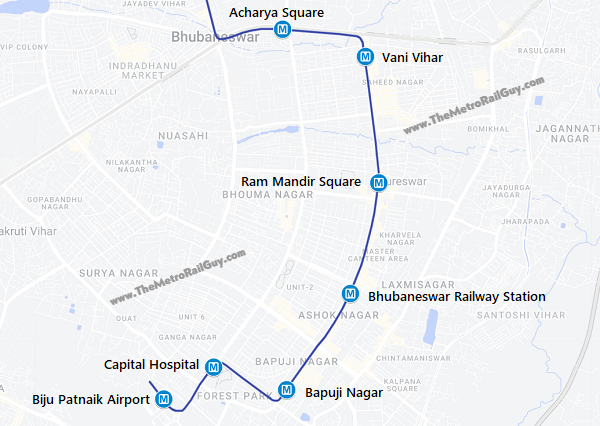Bids Invited for Bhubaneswar Metro’s Elevated Contract BBC-03
Delhi Metro Rail Corporation (DMRC) on Monday invited tenders for the civil construction work of Package BBC-03 of Bhubaneswar Metro Phase 1 project which will connect Trisulia Square – Biju Patnaik Airport via 20 elevated stations.
This 7.122 km long elevated section of 26 km Line-1 will link Capital Hospital to Acharya Vihar Square via 6 elevated stations at Capital Hospital, Bapuji Nagar, Bhubaneswar Railway Station, Ram Mandir Square, Vani Vihar and Acharya Vihar Square.
Package BCC-03 is located on the southern-end of the line, and is the second major civil package after Package BBC-02 which involves the construction of Phulapokhari Depot & Workshop on a 16 hectare parcel on the northern-end of the line.
- Deadline: 36 months (3 years)
- Estimated Cost: Rs. 630.65 crore
- Pre-bid Meeting: March 19, 2024 at 11 am
- Bid Submission Deadline: April 23, 2024 at 3 pm
- Technical Bid Opening: April, 2024 at 3 pm
DMRC’s Brief Scope: Part Design and Construction of Elevated Viaduct and Six Elevated Stations viz. Capital Hospital, Bapuji Nagar, Bhubaneswar Railway Station, Ram Mandir Square, Vani Vihar and Acharya Vihar Square (excluding Architectural finishing ) from Chainage 625.00 m to 7747.00 m of Bhubaneswar Metro Phase-I MRTS.

All stations’ exact location has been marked out on Google Maps over here.
Looking at the scope, a station earlier planned at Sishu Bhawan between Capital Hospital and Bapuji Nagar is no longer in the works. To compensate, I see Bapuji Nagar Station’s location has been moved a bit southward.
Biju Patnaik Airport Station and viaduct leading up to it will be constructed as part of a separate package after design approval from the Airports Authority of India (AAI). Construction west of Acharya Square will be carried out as part of Package BBC-04.
Package BBC-03’s construction will be funded entirely by the Government of Odisha and other appropriate means of Bhubaneswar Metro Rail Corporation Ltd (BMRCL). Interestingly, the tender documents also mention this is “Non-JICA funded work” which indicates Japan International Cooperation Agency has been approached by BMRCL for providing a loan to fund a part of the project – most likely the systems component comprising of rolling stock, signaling, telecommunication etc.
A list of all Bhubaneswar Metro civil & system tenders and their status / contractors can be viewed here.
For more updates, check out the Bhubaneswar Metro section or my Home Page! Sign up for free instant email notifications on new posts over here. Like this post? Get early-access to updates and support the site over here.
– TMRG




BMRCL ?
Bhubaneswar Metro Rail Corporation Ltd (BMRCL)
I think the estimate is too low. Typically we see about 100cr per km. This ofcousrse depends on the site conditions but I think the bids will be significantly higher than the estimate
Good to see quick progress by DMRC on putting out the first contracts.
A little sad to see location of the Bapuji Nagar station. It is closer to the Sishu Bhawan Junction rather than the Rajmahal Square. The latter is far more important, and station should have been closer to that, while still skipping Sishu Bhawan station.
Also would have been good to see the Bhubaneswar Railway Station station get a better name, and have been closer to the bus stand and upcoming railways station buildings. Hopefully elevated connections with walkalators will be built in future to make the connection easier.
Also, from the drawings it seems the stations are only being built for 2/3rd max length. May be 90-100m only, which would be enough for 3-4coach trains. While design outlines “future platforms” for further extensions of station to take place for probably allowing for 6 coach trains. Interesting choice to cut costs.
Nice to see the quick actions by DMRC.
I am little perplexed by shifting of the Bapuji Nagar station…it should be nearer to Rajmahal square, which is a major landmark with high footfall.
Also I am not sure how the cost is 100cr /km approx? It comes out to 250cr/km (grossly) for other metros. Am I missing something?
elevated metro costs are usually lower than underground metro costs. This is an entirely elevated project.
The average cost for elevated section ranges from 180-250cr/Km and Underground section from 300-450cr/km (Subject to different city, land and other costs). These figures are from metros in Cities like Indore, Bhopal, Nagpur, Agra etc. Hence I am not sure, how Bhubaneshwar metro is planned at such a low cost.
The 250cr per km is total system costs. This 100cr per km is more for just the basic civil contract for viaducts and stations. Doesnt include track work, electrification, rolling stock, finishing etc etc.
Yes. You are correct. The total budget of the metro is around 6000cr for 26km…which comes out roughly 230cr/km (similar to elevated metro cost elsewhere in India).
If Patna metro’s civil packages are names PC then why is Bhubaneswar not named BC?
‘BC’ was used for Delhi Metro’s Phase 2, so they had to come up with something unique
Is really a metro rail facility required for Bhubaneswar considering its population ? Why can’t we think to have two dedicated tracks on the existing East Coast Railway line from Balasore to Puri with 4 to 5 coaches with 15 minute frequency and feeding electric bus, auto transport facilities from all the express stations (in Cuttack- Bhubaneswar all the stations) from both sides of the stations developing road infrastructure and road network to all nook and corners of the city. Look at the population, the growth rate in next 20/30 years or 50 years. Bhubaneswar is growing in length not by its breadth. Western side is forest. We are encroaching to that side. Forest animals are entering in to the city. Think of that please. I don’t have any objection to this metro rail project. It is my city. It will enhance my image too. But, let us think, how to manage the investment, get the return and repay the loans. Think of who will use the metro rail and what will be their population and where from they will come and where will they commute.
While I agree there is probably no immediate desperate requirement for metro in Bhubaneswar unlike most other large or medium sized cities of India, I dont think we want to end up like those. Building metros 5 years after they were needed. I would much rather build them 3 years before that.
Something that is critical is to build a city around robust urban transport systems. Building the metro now will give Bhubaneswar a huge leg up in ensuring livability of the city for decades to come.
Also, fortunately, the state is able to fund the construction by itself. So there is less worry from a return/repayment perspective anyway. We have to look at this as an investment which will pay huge dividends for the city for decades to come.
It’s about building these systems ahead of time, as India’s population is projected to increase for the next several decades (While its urban population will increase at a much faster rate and for longer, even after the population peaks in the 2070s or so). 100s of millions of Indians will be moving from rural to urban areas over the next few decades, and those from Odisha will likely choose to move here as it’s the largest metropolitan area in the state.
This way, transit oriented housing can be built around stations to prevent urban sprawl, slums, and unauthorized colonies. In addition, it’s way cheaper than waiting until later, as land acquisition and labor costs will be much higher then.
Hey Contracts BBC-4 and BBC-5 are out too, but I think they goofed up on the tender drawings as they’ve put the drawings pdf for BBC-5 in BBC-4 as well. I hope that gets corrected soon cause I’m really interested to know where the station will be placed in the district centre area at chandrasekharpur.
Thanks for pointing out! Just posted here with credit to you at the bottom:
https://themetrorailguy.com/2024/03/13/bids-invited-for-bhubaneswar-metros-contracts-bbc-04-bbc-05/
😀 thank you for the honour, but if it weren’t for your article and your detailed analysis, I wouldn’t have had the scope to dwell deeper. So overall the real credit goes to you and your wonderful website. I would love to see you on YouTube if you aren’t already there.
I am actually interested in jaydev vihar station location and diagram, as the line has to cross NH-16 there, plus I suspect it will be an interchange station for next phase.
Till Acharya Vihar the viaduct is south of the highway. I imagine it will cross over to the other side between Acharya Vihar and Jaydev Vihar junctions, where the highway is at its low elevation. The Jaydev Vihar station will be on Nandankanan Road and not on the highway.
I was imagining a future line from Ananda Bana till Pahal, which would stay north of the highway for most of its run. An interchange station would be at Acharya Vihar with an additional station north of the highway, near the planetarium, which would be connected to the currently planned station south of the highway.
Congratulations DMRC for making a dream come true.
The option of underground metro atleast between the span from BapujiNagar to Vani Vihar would have given the city a grand feel. No doubt it would escalate the cost but the same would have resulted in creating an underground ecosystem apart from its futuristic advantages.